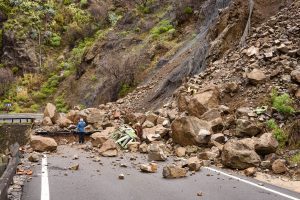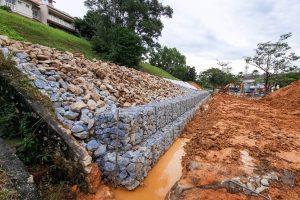Slope Stabilization
Use Man-made Structures and Landscaping Options To Prevent Hillside Instability

Slope Stabilization: you only need to follow the news to be aware of homes that are sliding down steep slopes and hills to their destruction. While your home likely isn’t in danger of imminent destruction, you need to recognize the signs that your hillside needs shoring up and understand the kinds of stabilization strategies that will help keep your property intact.
Experts say that a slope of 45 degrees or more is very likely to experience slides and slope failures as the natural force of gravity pulls the soil to the lowest point of the hill. The added stress of unusually heavy rainfalls brings the soil to the saturation point, making a slide or slope failure is nearly inevitable. Even if your neighborhood is prone to these types of events, you have some slope stabilization options available to you that can help protect your investment and even improve the appearance of your property.
Signs of slope instability
There are several things that will tell you that your hillside is in danger of collapsing or sliding away. The most obvious sign is segments of soil that have moved down the slope and then stopped. They often then remain in place long enough for grass to start growing on them again, but the danger of a more serious hillside collapse increases.
Another, less obvious but still telling, sign of slope instability is the appearance of the tree trunks on your property. Trees that have had soil move away from their underground root systems will lean in the direction of the slide. Even if the trees seem firmly rooted now, leaning trunks mean they’ve experienced soil erosion in the past and likely will again.
Slope Stabilization Structures
Your hillside might be a good candidate for a man-made structure designed to hold the soil in place. There are several different types of stabilization systems that will prevent erosion and landslides. One of the more popular Slope Stabilization systems is hillside terracing. Multi-level terraces offer soil erosion prevention as well as level areas suitable for gardening. An important factor you’ll need to consider when looking at terracing options is the water flow down and around the terraced areas. A construction company experienced in working with terraces can help you find the right design for your slope.
Retaining walls are another possible solution that can control hillside soil erosion. Retaining walls can be constructed of stone, brick, concrete or wood. There are benefits and drawbacks for each type of material, including the cost of installing the wall and the amount of time it’s expected to last. The kind of appearance you want the wall to have will also influence the type of material you choose. For example, you’ll want to use concrete bricks if your wall follows a curved section of your property, while rocks and boulders frequently offer a much more natural appearance.

Series of slope retention construction design with rocks and mesh to manage landslide in residential area
A gabion system is a slope stabilization method that has been used for hundreds of years and is again becoming popular. This method of hillside stabilization uses wire baskets filled with large rocks carefully selected to best retain the underlying soil while allowing water to drain properly. This type of system has been used more frequently for large, commercial projects but is now becoming more popular with homeowners dealing with steep and severe slopes.
Landscaping options
If your slope isn’t so steep that you can rappel down it, you might want to use landscaping options rather than manmade structures. Choosing the plants, shrubs and trees that can help hold the soil in place and your hill where it needs to stay just takes some research and sweat equity.
Landscape experts recommend selecting native plants to hold your hillside in place. Low-maintenance grasses, shrubs, trees and plants will grow with the water they get naturally and you won’t have to worry about keeping them alive during hot summers or cold winters. Native grasses spread and help hold in the soil with their extensive root systems, as do trees and shrubs.
By taking these simple steps to introduce slope stabilization to your property hillside, you won’t have to worry that your home will be the next one featured in the latest news about landslides. Instead, you can enjoy your home and property knowing that you’ve done all you can to keep your hillside in place.

